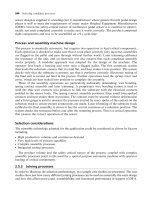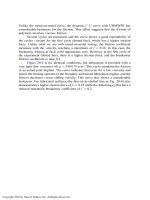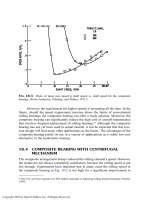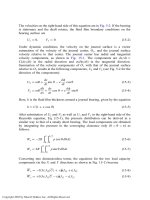Bearing Design in Machinery Episode 2 Part 6 doc
Bạn đang xem bản rút gọn của tài liệu. Xem và tải ngay bản đầy đủ của tài liệu tại đây (170.5 KB, 16 trang )
injection molding, where large quantities are manufactured in mass production,
resulting in low unit manufacturing cost. Plastic bearings can be used with or
without liquid lubrication. If possible, liquid lubrication should be applied,
because it reduces friction and wear and plays an important role in cooling the
bearing. Whenever liquid lubrication is not applied, solid lubricants can be
blended into the base plastics to reduce friction, often referred to as improving the
lubricity of plastics.
Polymer is synthetically made of a monomer that is a basic unit of chemical
composition, such as ethylene or tetrafluorethlene. The monomer molecules
always have atoms of carbon in combination with other atoms. For example,
ethylene is composed of carbon and hydrogen, and in tetrafluorethlene, the
hydrogen is replaced by fluorine. The polymers are made by polymerization; that
is, each monomer reacts with many other similar monomers to form a very long-
chain molecule of repeating monomer units (see Fig. 11-2). The polymers
become stronger as the molecular weight increases. For example, low-molecu-
FIG. 11-2 Examples of monomers and their multiunit polymers.
Copyright 2003 by Marcel Dekker, Inc. All Rights Reserved.
lar-weight polyethylene, which has at least 100 units of CH
2
, is a relatively soft
material. Increasing the number of units makes the material stronger and tougher.
The longest chain is ultrahigh-molecular-weight polyethylene (UHMWPE). It has
up to half a million units of CH
2
, and it is the toughest polyethylene. This
material has an important application as a bearing material in artificial replace-
ment joints, such as hip joints.
Over the last few decades, there has been an increasing requirement for
low-cost bearings for various mass-produced machinery and appliances. This
resulted in a dramatic rise in the development and application of new plastic
materials for bearings. It was realized that plastics are lighter and less expensive
than metals, have good surface toughness, can be manufactured by mass
production processes such as injection molding, and are available in a greater
variety than metallic sleeve bearings. In automotive applications, plastic bearings
have steadily replaced bronze bushings for most lightly loaded bearings. The
recent rise in the use of plastic bearings can also be attributed to the large volume
of research and development that resulted in a better understanding of the
properties of various polymers and to the development of improved manufactur-
ing technology for new engineering plastics. An additional reason for the
popularity of plastic bearings is the development of the technology of composite
materials. Fiber-reinforced plastics improve the bearing strength, and additives of
solid lubricants improve wear resistance. Also, significant progress has been
made in testing and documenting the properties of various plastics and compo-
sites.
Widely used engineering plastics for bearings include phenolics, acetals,
polyamides, polyesters, and ultrahigh-molecular-weight polyethylene. For many
applications, composites of plastics with various materials have been developed
that combine low friction with low wear rates and creep rates and good thermal
conductivity. Reinforced plastics offer a wide selection of wear-resistant bearing
materials at reasonable cost. Various plastics can be mixed together in the
polymer melt phase. Also, they can be combined in layers, interwoven, or
impregnated into other porous materials, including porous metals. Bearing
materials can be mixed with reinforcement additives, such as glass or carbon
fibers combined with additives of solid lubricants. There are so many combina-
tions that it is difficult to document the properties of all of them.
11.5.1.1 Thermoplastics vs. Thermosets
Polymers are classified into two major groups: thermoplastics and thermosets.
11.5.1.1.1 Thermoplastics
The intermolecular forces of thermoplastics, such as nylon and polyethylene,
become weaker at elevated temperature, resulting in gradual softening and
melting (similar to the melting of wax). Exposure to high temperature degrades
Copyright 2003 by Marcel Dekker, Inc. All Rights Reserved.
the polymer properties because the long molecular chains fracture. Therefore,
thermoplastics are usually processed by extrusion or injection molding, where
high pressure is used to compress the high-viscosity melt into the mold in order to
minimize the process temperature. In this way, very high temperature is not
required to lower the melt viscosity.
11.5.1.1.2 Thermosets
Unlike the thermoplastics, the thermosets are set (or cured) by heat. The final
stage of polymerization is completed in the mold by a cross-linking reaction
between the molecular chains. The thermosets solidify under pressure and heat
and will not melt by reheating, so they cannot be remolded. An example of
thermosets is the various types of phenolics, which are used for bearings. In the
first stage, the phenolics are partially polymerized by reacting phenol with
formaldehyde under heat and pressure. This reaction is stopped before the
polymer completely cures, and the resin can be processed by molding it to its
final shape. In the mold, under pressure and heat, the reaction ends, and the
polymer solidifies into its final shape. Although the term thermoset means ‘‘set by
heat’’, the thermosets include polymers such as epoxy and polyester, which do not
require heat and which cure via addition of a curing agent. These thermosets are
liquid and can be cast. Two ingredients are mixed together and cast into a mold,
where the molecular chains cross-link and solidify. In most cases, heat is supplied
to the molds to expedite the curing process, but it can be cured without heating.
11.5.1.2 Solid Lubricant Additives
Whenever liquid lubrication is not applied, solid lubricants can reduce friction
and wear. Solid lubricants are applied only once during installation, but better
results can be achieved by blending solid lubricants in the plastic material.
Bearings made of thermoplastics can be blended with a variety of solid lubricants,
resulting in a significant reduction of the friction and improved wear resistance.
Solid lubricant additives include graphite powder and molybdenum disulfide,
MoS
2
, which are widely used in nylon bearings. Additional solid lubricant
additives are PTFE and silicone, separately or in combination, which are blended
in most plastics to improve the friction and wear characteristics. The amount of
the various additives may vary for each plastic material; however, the following
are recommended quantities, as a fraction of the base plastic:
PTFE 15–20%
Silicone 1–5%
Graphite 8–10%
MoS
2
2–5%
Copyright 2003 by Marcel Dekker, Inc. All Rights Reserved.
These solid lubricants are widely added to nylon and acetal, which are good
bearing materials. In certain cases, solid lubricants are blended with base plastics
having poor tribological properties but desirable other properties. An example is
polycarbonate, which has poor wear resistance but can be manufactured within
precise tolerances and has relatively high strength. Bearings and gears are made
of polycarbonate blended with dry lubricants.
11.5.1.3 Advantages of Plastic Bearings
Low cost: Plastic materials are less expensive than metals and can be
manufactured by mass production processes, such as injection molding.
When mass-produced, plastic hearings have a far lower unit manufactur-
ing cost in comparison to metals. In addition, plastics can be easily
machined. These advantages are important in mass-produced machines,
such as home appliances, where more expensive bearings would not be
cost effective. In addition to initial cost, the low maintenance expenses
of plastic bearings is a major advantage when operating without liquid
lubricant.
Lubricity (self-lubrication): Plastic bearings can operate well with very
little or no liquid lubricant, particularly when solid lubricants are
blended with the base plastics. This characteristic is beneficial in
applications where it is necessary for a bearing to operate without
liquid lubrication, such as in the pharmaceutical and food industries,
where the lubricant could be a factor in contamination. In vacuum or
cryogenic applications it is also necessary to operate without oil
lubrication.
Plastic bearings have relatively high compatibility with steel
shafts, because they do not weld to steel. This property results in a
lower friction coefficient and eliminates the risk of bearing seizure. The
friction coefficient of plastic bearings in dry and boundary lubrication is
lower than that of metal bearings. Their friction coefficients range from
0.15 to 0.35, and coefficients of friction as low as 0.05 have been
obtained for certain plastics.
Conformability: This is the ability to deform in order to compensate for
inaccuracy of the bearing dimensions. Plastics are less rigid in compar-
ison to metals, and therefore they have superior conformability. Plastic
materials have a relatively low elastic modulus and have the ability to
deform to compensate for inaccuracy of the bearing-journal assembly.
Tolerances are less critical for plastics than for metals because they
conform readily to mating parts.
Vibration absorption: Plastic bearings are significantly better at damping
vibrations. This is an important characteristic, since undesirable vibra-
Copyright 2003 by Marcel Dekker, Inc. All Rights Reserved.
tions are always generated in rotating machinery. Also, most plastics can
absorb relatively high-impact loads without permanent deformation. In
many applications, plastic bearings are essential for quiet operation.
Embeddability: Contaminating particles, such as dust, tend to be embedded
into the plastic material rather than scoring, which occurs in metal
bearings. Also, plastics are far less likely to attract dust when running
dry, compared with oil- or grease-lubricated bearings.
Low density: Plastics have low density in comparison to metals. Light-
weight materials reduce the weight of the machine. This is an important
advantage in automotives and particularly in aviation.
Corrosion resistance: An important property of plastics is their ability to
operate in adverse chemical environments, such as acids, without
appreciable corrosion. In certain applications, sterility is an additional
important characteristic associated with the chemical stability of plas-
tics.
Low wear rate: Plastics, particularly reinforced plastics, have relatively
lower wear rates than metals in many applications. The exceptional wear
resistance of plastic bearings is due to their compatibility with steel
shafts and embeddability.
Design flexibility: Bearing parts can be molded into a wide variety of shapes
and can be colored, painted, or hot-stamped where appearance is
important, such as in toys and baby strollers.
Electrical insulation: Plastics have lower electrical conductivity in compar-
ison to metals. In certain applications, such as electric motors, sparks of
electrical discharge can damage the bearing surfaces, and an electrical
insulator, such as a plastic bearing, will prevent this problem.
Wide temperature range: Plastics can operate without lubricants, at low and
high temperatures that prohibit the use of oils or greases. Some plastics
have coefficients of friction that are significantly lower at very low
temperatures than at room temperature. Advanced engineering plastic
compounds have been developed with PV ratings as high as 1230 Pa-
m=s (43,000 psi-fpm), and they can resist operating temperatures as high
as 260
C. But these compounds are not as low cost as most other
plastics.
11.5.1.4 Disadvantages of Plastic Bearings
A major disadvantage is low thermal conductivity, which can result in high
temperatures at the bearing surface. Most low-cost plastic materials cannot
operate at high temperatures because they have low melting temperatures or
because they deteriorate when exposed continuously to elevated temperatures.
The combination of low thermal conductivity (in comparison to metals) and low
Copyright 2003 by Marcel Dekker, Inc. All Rights Reserved.
melting temperatures restricts plastic bearings to light-load applications and low-
speed (low PV rating in comparison to metals). The adverse effect of low thermal
conductivity can be reduced by using a thin plastic layer inside a metal sleeve, but
this is of higher cost. The following are additional disadvantages of plastic
materials in bearing applications.
Plastics have a relatively high thermal coefficient of expansion. The
difference in the thermal coefficient of expansion can be 5–10 times greater for
plastics than for metals. Innovative bearing designs are required to overcome this
problem. Several design techniques are available, such as an expansion slot in
sleeve bearings. The effect of thermal expansion can be minimized by using a
thin plastic layer inside a metal sleeve so that expansion will be limited in overall
size. If thermal expansion must be completely restrained, structural materials can
be added, such as glass fibers.
Another general disadvantage of plastics is creep under heavy loads, due to
their relatively low yield point. Although plastics are compatible with steel shafts,
they are not recommended to support nonferrous shafts, such as aluminum, due to
the adhesion between the two surfaces.
11.5.1.5 PTFE (Te£on)
PTFE (Teflon) is a thermoplastic polymer material whose unique characteristics
make it ideal for bearing applications (Tables 11-2 and 11-3). The chemical
composition of PTFE is polytetrafluoroethylene. The molecular structure is
similar to that of ethylene, but with all the hydrogen atoms replaced by fluorine
(see Fig. 11-2). The characteristics of this structure include high chemical
inertness due to the strong carbon-fluorine bonding and stability at low and
high temperatures. It has very low surface energy and friction coefficient. At high
loads and low sliding velocity, the friction coefficient against steel is as low as
0.04.
PTFE is relatively soft and has low resistance to wear and creep. However,
these properties can be improved by adding fibers or particulate of harder
materials. Wear resistance can be improved 1000 times by these additives.
TABLE 11-2 Bearing Design Properties of PTFE
Max
pressure
Max
velocity PV
Max
Temp.
Material MPa Psi m=sft=min psi-ft=min Pa-m=s
C
F
PTFE 3.4 500 0.51 100 1000 35,000 260 500
Reinforced PTFE 17.2 2500 5.1 1000 10,000 350,000 260 500
Copyright 2003 by Marcel Dekker, Inc. All Rights Reserved.
0.1. It has a wide operating temperature range, and can be applied at higher
temperatures relative to other plastics and white metal. In addition, PTFE can be
added to other materials in order to decrease friction. A thin layer, referred to as a
third body layer, is formed on the surface and acts as a solid lubricant. Another
important advantage of PTFE is its ability to resist corrosion, including that by
strong acids.
The advantages of PTFE as a bearing material can be summarized as
follows.
1. It has the lowest dry friction in comparison to any other solid material.
2. It has self-lubricating property and acts as a thin layer of a third body to
lower the friction when added to other materials.
3. It retains strength at high temperature relative to white metals and other
plastics.
4. There is no cold-welding, which causes seizure in metal contacts.
5. It is chemically inert and therefore resists corrosion.
6. It can elongate elastically up to 400% and then return to its original
dimensions; thus PTFE bearings are useful in applications that require
better resistance to impact loading.
However, PTFE also has several disadvantages in bearings. The two major
disadvantages are its high cost and its relatively low load capacity. In addition, it
has a tendency to creep under load. In order to overcome the last problem, PTFE
resin is usually applied in modified forms, such as reinforced by glass fibers or
graphite fibers. Unmodified PTFE has a PV rating of only 35,000 Pa-N=m
2
(1000 psi-fpm), whereas PTFE filled with glass or graphite fibers has a PV rating
of more than 10,000 psi-fpm. It means that the PV as well as the maximum
sliding speed of PTFE filled with glass or graphite fibers is ten times that of PTFE
without reinforcement. Additional disadvantages are its low stiffness as well as its
relatively high coefficient of thermal expansion.
The most important disadvantages of PTFE as bearing material can be
summarized as follows.
1. It is relatively expensive because it is difficult to manufacture. In
particular, it is difficult to control its molecular weight and the degree
of cross-linking, which determines its rigidity.
2. It exhibits low load capacity (low resistance to deformation) and has
very high rates of creep and fatigue wear relative to other plastics.
3. It has very high thermal expansion.
PTFE has many applications in machinery for sliding contacts. It finds
application in journal and sliding bearings, as well as in rolling-element bearing
cages. Also, it is used for gaskets, seals, and piston rings. It is modified and added
to porous metals, such as in sintered bronze. It is often reinforced by various
Copyright 2003 by Marcel Dekker, Inc. All Rights Reserved.
materials, such as fiberglass, metal powders, ceramics, and graphite fibers. Other
fillers, such as polyester, cotton, and glass, are also used. The fillers do not
eliminate the low-friction characteristic due to the formation of a third body,
which demonstrates very low friction against other solid materials. These
combinations improve the properties and enable the manufacture of bearings
and sliding parts with improved friction properties. Examples include automotive
joints, aircraft accessories, textile machines, and business machines. Its chemical
inertness is an important advantage in chemical and food-processing machinery.
Reinforced PTFE has strong bonds to steel and other rigid backing
material. Reinforced PTFE liners are used in high-load, low-speed bearings to
eliminate oil lubrication. Woven fabrics impregnated with PTFE are used in
automotive thrust washers, ball-and-socket joints, aircraft controls and acces-
sories, bridge bearings, and electrical switches. Woven PTFE fabrics are easily
applied to bearing surfaces, they resist creep and are used for relatively higher
loads.
11.5.1.6 Nylon
Nylons (polyamides) are widely used thermoplastic engineering polymers. Nylon
is a crystalline material that has a variety of compositions and that can be formed
by various processes, including injection molding, extrusion, and sintering. The
most widely used composition is nylon 6=6, which is used primarily for injection
molding and extrusion (Tables 11-4 and 11-5). Nylons are used in the form of
reinforced compounds, such as glass-fiber composites, to improve strength and
toughness as well as other properties.
Generally, the nylons have relatively high toughness and wear resistance as
well as chemical resistance, and excellent fatigue resistance. Their low friction
coefficient makes them a very good choice as bearing materials. However, they
absorb water and expand. This property causes them to have low dimensional
stability in comparison to other engineering plastics. Moisture adversely affects
their strength and rigidity while improving their impact resistance. Nylon has the
widest use of all engineering plastics in bearings. Nylon bearings are used mostly
in household appliances, such as mixers and blenders, and for other lightly loaded
applications. Nylon resins are used extensively in the automobile industry
because they are resistant to fuels and heat and can be used under the hood of
TABLE 11-4 Design Properties of Nylon
Max pressure Max velocity PV
Max
Temp.
Material MPa Psi m=sft=min psi-ft=min Pa-m=s
C
F
Nylon 6.9 1000 5.1 1000 3000 105,000 93 200
Copyright 2003 by Marcel Dekker, Inc. All Rights Reserved.
well as the coolant. This design frequently avoids the necessity for fluid sealing
and prevents contamination. Like most plastics, nylon has good antiseizure
properties and softens or chars, rather than seizing.
Like most plastics, nylon has a low thermal conductivity (0.24 W=m
C),
which is only about 0.5% of the conductivity of low carbon steel (54 W=m
C).
The heat generated in the bearing by friction is not transferred rapidly through the
nylon sleeve, resulting in high operating temperatures of the bearing surface.
Therefore, these bearings usually fail under conditions of high PV value. In
hydrodynamic bearings, the heat transfer can be enhanced by a large flow rate of
oil for cooling.
The main disadvantage of the nylon bearing is creep, although the creep is
not as large as in other, less rigid thermoplastics, such as PTFE. Creep is the
plastic deformation of materials under steady loads at high temperatures for long
periods of time. To minimize this problem, nylon bearings are supported in metal
sleeves or filled with graphite. The added graphite improves wear resistance and
strength. A second important disadvantage is nylon’s tendency to absorb water.
11.5.1.7 Phenolics
Phenolic plastics are the most widely used thermosetting materials. They are used
primarily in reinforced form, usually containing organic or inorganic fibers.
Compression molding, injection molding, and extrusion can process phenolics.
They are low-cost plastics and have good water and chemical resistance as well as
heat resistance (Tables 11-6 and 11-7). As bearing materials, phenolics exhibit
very good resistance to seizure.
Phenolics have excellent resistance to water, acids, and alkali solutions.
Phenolic bearings can be lubricated by a variety of fluids, including process
fluids, due to their chemical resistance. However, these bearings have a disad-
vantage in their thermal conductivity. The thermal conductivity of phenolics is
low (0.35 W=m
C). The heat generated in the bearing by friction cannot be easily
transferred through the phenolic sleeve, resulting in slow heat transfer and a high
temperature of the rubbing surfaces. Phenolic bearings usually fail under
conditions of high PV value. This problem can he solved by proper designs.
Large, heavily loaded bearings must have a large feed of lubricating oil for
cooling.
TABLE 11-6 Bearing Design Properties of Phenolics
Max pressure Max velocity PV Max Temp.
MPa Psi m=sft=min psi-ft=min Pa-m=s
C
F
41.4 6000 12.7 2500 15,000 525,000 93 200
Copyright 2003 by Marcel Dekker, Inc. All Rights Reserved.
exposure to 500
F reduces its tensile strength from 9600 to 7500 psi, but
continuous exposure (up to 4000 hours) would not cause further deterioration
(Table 11-8). It has very low thermal expansion for plastic, about twice the
expansion rate of aluminum. When operating dry, it has a relatively low
coefficient of friction.
Polyamide is expensive relative to other engineering plastics; and, similar to
nylon, it has a tendency to absorb water. Dry bearings, bushings, thrust washers,
piston rings, gears, and ball bearing cages are often manufactured using
polyamide, most of them designed for high-temperature operation.
This group of engineering plastics has varying properties. They have
excellent resistance to chemical attack and to burning. Polyamide is noted for
its high surface toughness and its long service life. A disadvantage of this group
is that they tend to absorb moisture. Polyamides are usually used with fillers. The
use of fillers creates useful materials for bearings with PV factors of 20,000–
30,000 psi-fpm. Polyamide with 15% graphite filler by weight is widely used. The
filler improves the characteristics, raises the limiting temperature of 550
F, and
increases its PV rating 10-folds to 300,000 psi-fpm. The reinforced polyamide is
also more resistant to wear and creep in comparison to unfilled polyamide.
Polyamides are often filled with glass fibers to improve their compressive strength
and resistance to creep.
11.5.1.9 Acetal
Acetal is a rigid plastic that is used as a bearing material due to its low cost,
particularly for light-duty (low-load) applications. Acetal has a low density that is
important in certain applications, such as aviation. It is tough over a wide range of
temperatures; however, it has a maximum useful temperature of only 185
F.
TABLE 11-8 Bearing Design Properties of Polyamide
Characteristic General purpose Bearing grade
Coefficient of thermal expansion
ð10
À5
 in:=in:-
FÞ
2 1.3–1.5
Specific gravity 1.40 1.45
Water absorption % (24 h,1=8 in. thick) 0.28 0.20
Tensile strength (psi) @ 300
F 15,200 9,600
Elongation (%) @ 300
F177
Tensile modulus (10
5
psi)
Hardness (Rockwell R)
Flexural modulus ð10
5
psi) @ 300
F 5.2 7.3
Impact strength (Izod, ft-lb.=in.) 2.5 1.1
Copyright 2003 by Marcel Dekker, Inc. All Rights Reserved.
Although strong acids and bases can attack it, acetal is inert to many chemicals,
particularly organic solvents (Tables 11-9 and 11-10).
Acetal has higher compressive strength in comparison to unfilled poly-
amides. It has a PV rating of 3000 psi-fpm, similar to that of nylon 6=6. Acetal on
steel does not demonstrate stick-slip friction, which is important for quiet bearing
operation. This property is associated with the friction coefficient of acetal on
steel, which increases with the sliding speed. However, its major disadvantages
are that it has a higher wear rate and is not as abrasion resistant, e.g., in
comparison to polyamides.
Acetal demonstrates stability in a wet environment, due to its low moisture
absorption as well as its resistance to wet abrasion. Acetal is commonly used in a
wide variety of automotive, appliance, and various other industrial applications.
When acetal is filled with internal lubricants, it yields lower friction than
nonlubricated acetal; however, this significantly raises its cost and lowers its
compressive strength. Applications include ball bearing cages and a number of
aviation applications that take advantage of its very low density.
TABLE 11-9 Bearing Design Properties of Acetal
Max pressure Max velocity PV
Max
Temp.
Material MPa Psi m=sft=min psi-ft=min Pa-m=s
C
F
Acetal 6.9 1000 5.1 1000 3000 105,000 82 180
TABLE 11-10 Physical and Mechanical Properties of Acetal
Characteristic Copolymer Homopolymer
Coefficient of thermal expansion ð10
À5
 in:=in:-
CÞ 8.5 10
Specific volume (in:
3
=lb) 19.7 19.5
Water absorption % (24 h,1=8 in. thick) 0.22 0.25
Tensile strength (psi) @ 73
F 8000 10,000
Elongation (%) 60 40
Thermal conductivity (BTU-in.=h-ft
2
-
F) 1.6 2.6
Tensile modulus ð10
5
PSI) 4.1 5.2
Hardness (Rockwell M)8094
Flexural modulus ð10
5
psi) @ 73
F 3.75 4.1
Impact strength (Izod, ft-lb.=in.) (notched) 1.3 1.4
Thermal conductivity (BTU=h-ft-
FÞ 0.46 0.74
Copyright 2003 by Marcel Dekker, Inc. All Rights Reserved.
11.5.1.10 High-Density Polyethylene (UHMWPE)
Ultra high-molecular-weight polyethylene (UHMWPE) (Table 11-11) has good
abrasion resistance as well as a smooth, low-friction surface. The friction
coefficient of UHMWPE on steel increases with the sliding speed. This
characteristic is important, because it does not result in stick-slip friction and
produces quiet bearing operation. It is often used in place of acetal, nylon, or
PTFE materials. One important application of UHMWPE is in artificial joint
implants. For example, in hip joint replacement, the socket (bearing) is made of
UHMWPE, while the matching femur head replacement is fabricated from
cobalt-chromium steel. More information on artificial joint implants is in Chap.
20.
11.5.1.11 Polycarbonate
Polycarbonate plastics are used as a bearing material in applications where the
bearing is subjected to high-impact loads. Polycarbonates have exceptionally high
impact strength over a wide temperature range. They are high-molecular-weight,
low-crystalline thermoplastic polymers unaffected by greases, oils, and acids
(Tables 11-12 and 11-13).
Polycarbonates have been tested for balls in plastic ball bearings for use in
army tank machine gun turrets, where its toughness is a prime consideration.
11.5.2 Ceramic Materials
There is an increasing interest in bearing materials that can operate at elevated
temperatures, much higher than the temperature limit of metal bearings. Ceramic
materials are already used in many applications in machinery, and there is
continuous work to develop new ceramic materials. The most important qualities
TABLE 11-11 Physical and Mechanical Properties of UHMWPE
Characteristic Low-density UHMWPE
Specific volume (in:
3
=lb) 30.4–29.9 29.4
Water absorption % (24 h,1=8 in. thick) <0.01 <0.02
Tensile strength (psi) 600–2300 4000–6000
Elongation (%) 90–800 200–500
Tensile modulus (10
5
psi) 0.14–0.38 0.2–1.1
Hardness (Rockwell R)1055
Flexural modulus ð10
5
psi) 0.08–0.60 1.0–1.7
Impact strength (Izod, ft-lb.=in.) No break No break
Thermal conductivity (BTU=h-ft-
FÞ 0.67 0.92
Copyright 2003 by Marcel Dekker, Inc. All Rights Reserved.
tivity in comparison to metals. In rolling-contact applications, rolling elements
made of silicone nitride exhibit much better fatigue resistance in comparison to
steel.
However, ceramics have also several disadvantages. Ceramic bearings are
much more expensive to manufacture than their steel counterparts. The manu-
facturing cost of ceramic parts is two to five times the cost of similar steel parts.
Ceramic parts are very hard, and expensive diamond-coated tools are required for
machining and cutting ceramic parts. Ceramic materials are brittle and do not
have plastic deformation; therefore, ceramic parts cannot be shaped by plastic
deformation like metals. In addition, ceramics are not wear-resistant materials,
because they are very sensitive to the traction force during rubbing (although
silicone nitride has demonstrated wear resistance in rolling contact).
Ceramics have additional disadvantages. A major characteristic is their
brittleness and low tensile stress. They exhibit no plastic behavior; therefore,
stress concentration will cause failure. Ceramics deform elastically up to their
fracture point. Their high modulus of elasticity results in fracture at relatively
small strains. When used in conjunction with steel shafts and housings, they
create fitting problems due to their low linear thermal expansion in comparison to
steel. In very high- and very low-temperature environments, these problems are
exacerbated.
11.5.2.1 Hot Isostatic Pressing (HIP)
Ceramic parts are manufactured from powder by hot-press shaping or by the
improved manufacturing technique of hot isostatic pressing (HIP). This last
technique offers many advantages of improved mechanical characteristics of the
parts. The early manufacturing process of ceramics was by hot-pressing. The
parts did not have a uniform structure, and many surface defects remained, to be
removed later by various expensive processes. The parts were not accurate and
required finishing machining by diamond-coated cutting tools. Moreover, the
finished parts did not have the characteristics required for use in rolling-element
bearings.
The recently introduced hot isostsatic pressing (HIP) process offered many
advantages over the previous hot-pressing process. The HIP process uses very
high pressure of inert gas at elevated temperatures to eliminate defects of internal
voids. High-pressure argon, nitrogen, helium, or air is applied to all grain surfaces
under uniform temperature. Temperatures up to 2000
C (3630
F) and pressures
up to 207 MPa (30,000 psi) are used. The temperature and pressure are accurately
controlled. This process bonds similar and dissimilar materials, to form parts very
close to the final shape from metals, ceramic, and graphite powders. The term
isostatlc means that the static pressure of the hot gas is equal in all directions
throughout the part.
Copyright 2003 by Marcel Dekker, Inc. All Rights Reserved.
This process is already widely used for shaping parts from ceramic powders
as well as other mixtures of metals and nonmetal powders. This process
minimizes surface defects and internal voids in the parts. The most important
feature of this process is that it results in strong bonds between the powder
boundaries of similar or dissimilar materials. In turn, it improves significantly the
characteristics of the parts for many engineering applications.
In addition, the HIP process reduces the cost of manufacturing, because it
forms net or near-net shapes (close to the required dimensions of the part). The
cost is reduced because the parts are near final and very little machining is
required.
11.5.2.2 Engineering Ceramics
Ceramics have been used in bearings for many years in low-load applications
where lubrication is limited or not possible. An example is the small sphere of
alumina used in accurate instruments or mechanical watches. These bearings are
commonly referred to as ‘‘watch jewels.’’ However, these are not engineering
ceramics. There is a need for bearings for high-temperature applications at high
speed and load, such as aircraft engines. For this purpose, a lot of research and
development has been conducted in engineering ceramics.
Engineering ceramics are dissimilar to regular ceramics, such as porcelain
or clay bricks, because of their much higher strength and toughness at high
operating temperatures. Engineering ceramics are compounds of metallic and
nonmetallic elements, such as Si
3
N
4
, SiC, and Al
2
O
3
, that are sintered at high
pressure and temperature by HIP process in order to form a strong bond between
the particles. In conventional ceramics (porcelain), the particles are linked by
weak bonds (mechanical linkage of particles). On the other hand, sintered
engineering ceramics that are made by a hot-pressed or hot-isostatically-pressed
process have particles that are bonded together by a stronger bond. The physical
explanation for the improved properties of engineering ceramics is that they have
strong bonds at the grain boundaries. The energy of equilibrium of these bonds is
similar to that of metal grains.
During the last two decades, there were a lot of expectations that ceramics
materials would be used in engines, including piston and sleeve materials. This
would allow operation of the engines at higher temperatures, resulting in
improved efficiency. We have to keep in mind that according to the basic
principles of thermodynamics (Carnot cycle), efficiency increases with engine
temperature. These expectations did not materialize at this time, because ceramic
surfaces require liquid lubricants (in a similar way to metals). However, liquid
lubricants that can operate at elevated temperatures in conjunction with ceramics
are still not available. Research was conducted in an attempt to operate ceramic
bearings at high temperatures with various types of solid powders as lubricants.
Copyright 2003 by Marcel Dekker, Inc. All Rights Reserved.
However, this work did not reach the stage of successful implementation in
bearings.
The ceramic materials proved to have inferior tribological properties, such
as relatively high sliding wear in comparison to compatible metal bearing
materials. A large volume of research was conducted, and is still taking place,
in an attempt to improve the tribological properties of engineering ceramics by
various coatings or surface treatment. During the sliding of ceramics against steel,
adhesive wear has been identified as the major wear mechanism. Let us recall that
adhesive wear is affected by the lowest shear strength of the sliding bodies and by
the compatibility of the two materials. Although some improvements have been
reported, ceramic bearing materials are still not widely used for replacement of
metals in plain bearings.
The main engineering ceramics in use, or in the development stage, are
silicon nitride, silicon carbide, zirconia, alumina oxide, and ruby sapphire. Silicon
carbide and silicon nitride are already used in various applications as high-
temperature and high-strength engineering ceramics. The purpose of the follow-
ing discussion is to provide the bearing designer a summary of the unique
characteristics of engineering ceramics that can make them useful candidates as
bearing materials. Bearings made of ceramics are of significant interest for the
following reasons.
1. High-temperature performance: Ceramics retain high strength at
elevated temperature and have a relatively high yield-point stress at
temperatures above 1000
C (1832
F). This is a major advantage for
potential high-temperature bearing materials. However, the available
lubricants do not resist a similarly high temperature, and it is necessary
to operate the bearing without lubricant. Air is considered a potential
fluid film that can operate at elevated temperatures and can be used for
hydrostatic or hydrodynamic lubrication. In some unique applications,
such as high-speed small turbines, ceramic air bearings are already in
use. In the future, it is expected that ceramics will be increasingly used
for high-temperature applications, such as in aircraft engines.
2. Low density: An additional advantage of ceramic materials is that
their density is relatively low. The density of ceramics is about a third
that of steel. For example, low density reduces the centrifugal forces of
rotating rolling elements. It reduces the contact stresses between the
rolling elements and the outer race. This fact allows the operating of
rolling bearings at higher speed.
3. Low coefficient of expansion: In general, a low coefficient of expan-
sion is desirable, in particular in rolling-element bearings. Thermal
stresses, due to thermal expansion, cause seizure in sleeve bearings as
well as in rolling-element bearings. However, other parts in the
Copyright 2003 by Marcel Dekker, Inc. All Rights Reserved.
machine are usually made of steel, and there is a compatibility problem
due to the difference in thermal expansion. A major problem is the
difficulty of mounting ceramic bearings on metallic shafts and inside
metallic housings, because of the large differences in thermal expan-
sion coefficient between metals and ceramics.
4. Corrosion resistance: Ceramics are chemically inert and have good
corrosion resistance. Ceramics can be used in a corrosive environment,
such as strong acids, where steel alloys fail due to fast corrosion.
Although ceramics are not ideal tribological materials, they are considered
by many to be the future technology. Ceramics enable operation at temperature
ranges not previously accessible. They allow grease lubrication or unlubricated
applications where steel requires more expensive and complex oil lubrication
equipment.
In general, ceramics are expected in the future to replace metals in order to
reduce weight and allow higher temperatures to increase engine efficiency and
speed of operation. By using ceramics in gas turbines, the operating temperature
will increase from the metal limited range of 1800–2100
F to 2500
F. This would
result in considerable fuel savings. The characteristics of ceramic bearings, when
fully used, not only would reduce fuel consumption, but also will reduce
maintenance cost and increase power density (engine weight), which is particu-
larly important in aircraft. The ability of ceramic rolling elements to operate with
very little or no lubrication offers great potential for improving aircraft safety.
11.5.2.3 Ceramics for Plain Bearings
In ceramics, adhesive wear has been identified as the most significant mechanism
of sliding wear against bearing steel. As was discussed in Sec. 11.2.1, adhesive
wear is influenced by two factors—the shear strength of the sliding pair and the
compatibility of the two materials.
Attempts were made to modify ceramic material surfaces to minimize the
adhesive wear so that they would be competitive with metal plain bearings. For
example, experiments have been conducted to improve the wear resistance of
silicon nitride by adding whiskers of silicon carbide in various amounts (Ueki,
1993). The results showed that silicon carbide improves fracture toughness,
which is correlated with reduced wear.
It is already known that water is a good lubricant for ceramic sliding
friction. Tests of the effect of water on ceramic slideways were conducted*. For
all ceramics it was found that the coefficient of friction decreases with increasing
humidity. Zirconia demonstrated the highest friction coefficient and wear rates,
relative to other ceramics. Zirconia’s wear rate increased dramatically with
increasing sliding velocity when submersed in water, while the wear rates of
*Fischer and Tomizawa, 1985; Tomizawa and Fischer, 1987; and Ogawa and Aoyama, 1991.
Copyright 2003 by Marcel Dekker, Inc. All Rights Reserved.









